Toshiba Qosmio F755-3D290: Glasses-Free 3D?
by Dustin Sklavos on November 23, 2011 1:10 AM ESTApplication and Futuremark Performance
We've seen the Intel Core i7-2630QM and NVIDIA GeForce GT 540M paired together enough times that performance is going to be fairly predictable, but unfortunately Toshiba drops the ball hardcore by including a dismally slow 5,400-RPM hard drive, inexcusable on any notebook north of a grand. The result is, as you'll see, a notebook that falls a bit behind competing systems with similar configurations, particularly in PCMark.
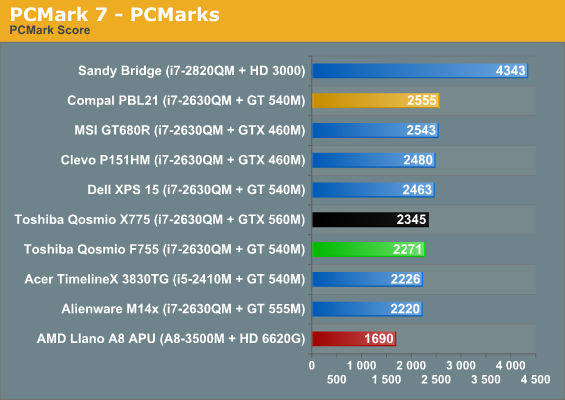
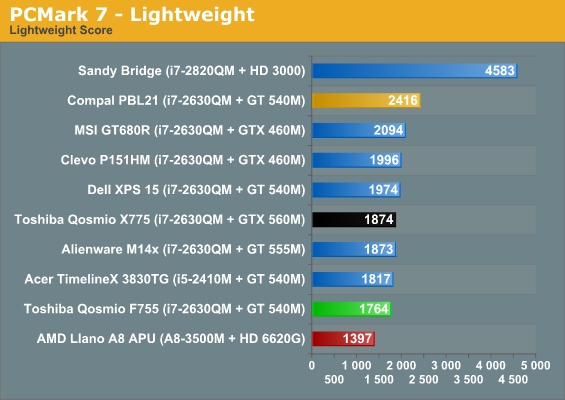
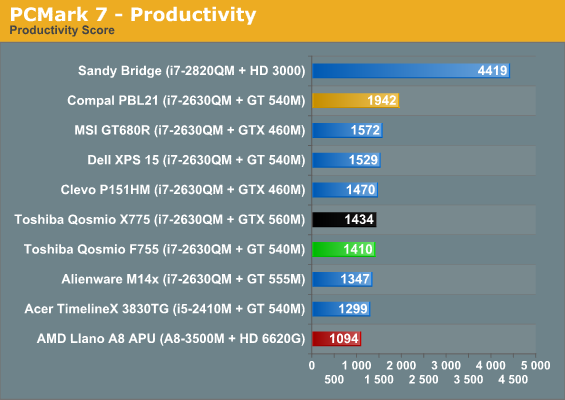

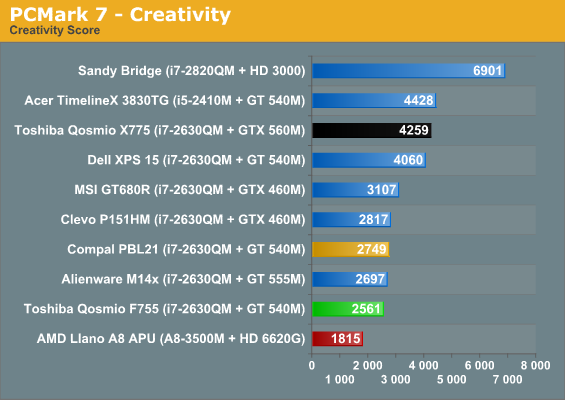
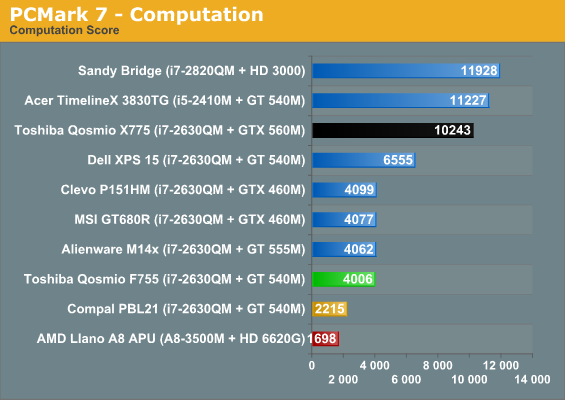
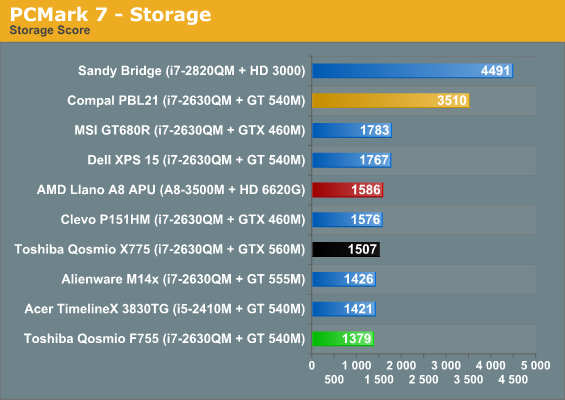
Well, that's too bad. You can see the units that were equipped with SSDs fare better at the storage benchmark, but really, the F755's slow hard drive causes it to come in dead last out of this grouping. In a crowd of similarly-configured notebooks, the F755 puts in a weak showing.

PCMark Vantage seems to be a bit more generous with the F755, giving it a score that hangs out nicely in the middle of the road.
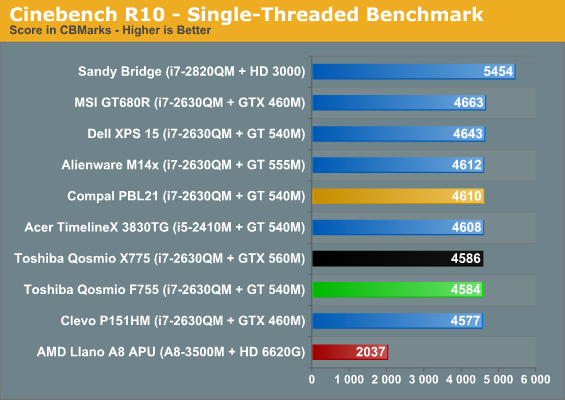
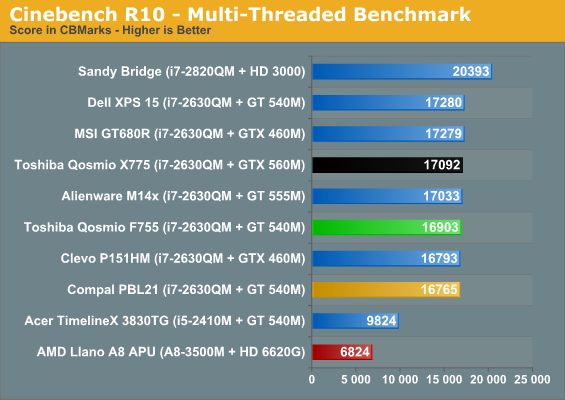
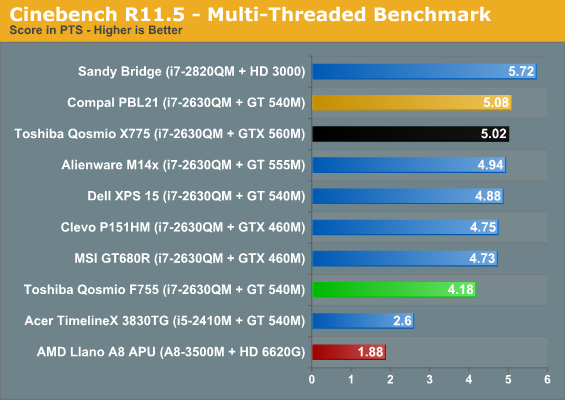
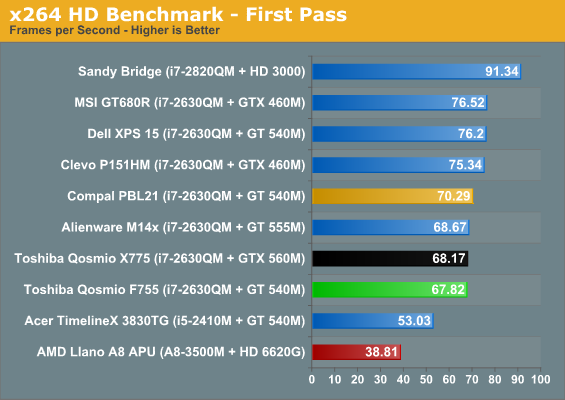

I've always been fond of how consistent Cinebench can be; it's actually one of my favorite benchmarks, and I like having both R10 and R11.5 here because R10 feels more absolute in terms of comparative performance while R11.5 seems better at teasing out minor differences in configurations. While it's not any great difference, the F755 is measurably, consistently slower than other i7-2630QM-equipped notebooks.
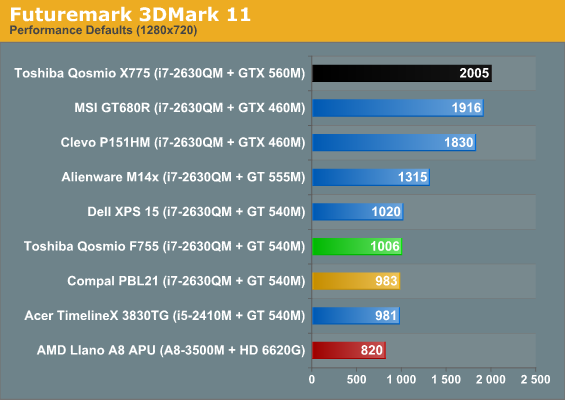
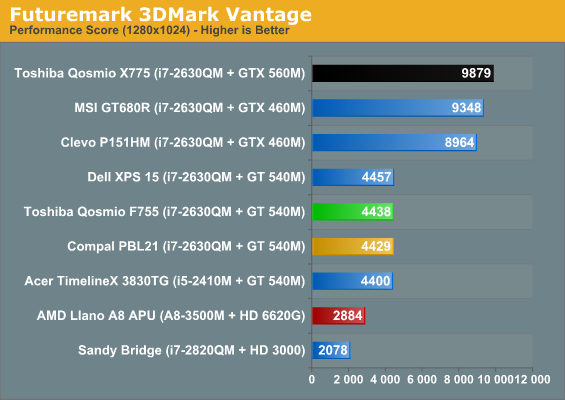
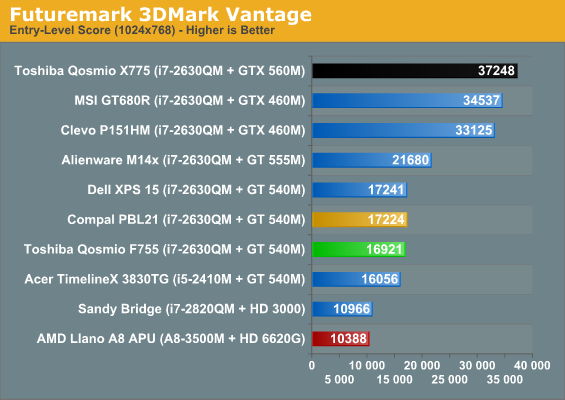
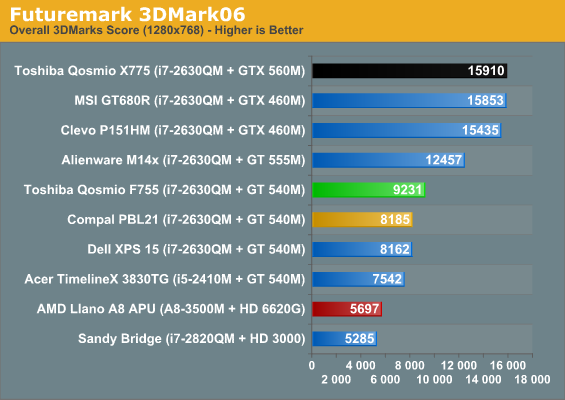
The 3DMarks are also very consistent across the review units. The GT 540M-equipped notebooks all pretty much line up, with 3DMark06 being the only odd man out, boasting a substantially higher score than the others. This should hopefully offer some confirmation that NVIDIA's Optimus is almost all upside.










16 Comments
View All Comments
chillmelt - Wednesday, November 23, 2011 - link
Color me blind but.. really? Why is the weakest A8 APU always being compared to some of Intel's best CPUs, on stock settings (reference sample) no less? An appropriate A8 APU can at least run around with a 6770M GPU. It's not like laptops with 3530-MX and discrete GPUs don't exist...silverblue - Wednesday, November 23, 2011 - link
I can see your point. The 3500M has a stock speed of 1.5GHz and turbo of 2.4GHz, whereas the 3530MX is 1.9/2.6. Even if you spend all your time at turbo with a single thread, it's still going to be a little faster in anything but GPU-limited situations, and for general workloads, decently quicker. However, perhaps AMD haven't sent one over to AT just yet; we can't expect a review on something they've not been given.I'm quite pleased to see the 3500M still very high up the battery charts even with a relatively small battery. A 3530MX with a 71Wh battery would be sweetness indeed if only they could attach a decent panel to the thing.
ckryan - Wednesday, November 23, 2011 - link
I just continue to be amazed at the ridiculous nature of displays being ham-fisted into laptops these days. On average, even high end laptops have dismal screens, so when a laptop has a decent screen it's reason to take notice. If there was one thing I could convince manufacturers like Dell, HP, Toshiba, Samsung, Sony, etcetera etcetera, it's that the display is so vitally important. Years back, everyone wanted a laptop. Now everyone wants a tablet. I use laptops less and less (when I can help it, that is) because my $99 TouchPad has a superior display. Now, I need a laptop and couldn't accept a tablet as a replacement but many can. Better screens won't stop the slide of laptops, but I think it would help. I know I won't buy another laptop until I can get one with a display in the style of my desktop, TV, and tablet (which is to say, good and IPS). It's difficult to tell people what it's all about, but I believe consumers with exposure to great displays are going to catch on to laptops with similar screens even if they aren't hip to the nomenclature.The Qosmio may have a terrible display, but it's not in rare company. In the same way, Dustin's AIO reviews reveal that if you're going to buy an all in one, display options are not stellar their either. Dell is the 800lb gorilla with questionable judgement -- Dell has an eIPS touch screen desktop monitor, but won't put it in their AIO. Getting a decent panel in a Dell notebook is like playing Russian Roulette. In the mean time, Apple is pushing better displays in mobile products and their AIOs. You'd figure with all the cribbing going on that PC makers could at least steal Apple's idea to put a halfway decent LCD in a product. Macbooks have TN panels, but at least Apple gives you a less-than-godawful TN panel for your money. Sure, some laptops don't have awful displays, but that's just because the bar is set so damn low.
ananduser - Wednesday, November 23, 2011 - link
Well HP has IPS Radiance displays in their 15" Envy. Sony has some nice mate screens going on. Things aren't so bleak as you make them sound.r3loaded - Wednesday, November 23, 2011 - link
There are several people like you and me (at least certainly on the internet) who yearn for a decent screen in a laptop. While HP do offer IPS in their Envy and EliteBooks and Lenovo have some high-end laptops with similar screens, the rest of the market offers nothing. The new AOC monitor that was just announced has shown it's possible to make a 23 inch IPS monitor for $200 (even if it's eIPS rather than H-IPS), which is not a lot more than TN competitors. It's therefore possible to make laptops with IPS screens that don't cost insane amounts.Unfortunately, manufacturers are still stuck in their race to the bottom mentality, and still can't work out how to build a laptop from good quality materials with a good screen. It's borderline insane that a $500 tablet has a better screen and build quality than several $1000+ laptops.
Draconian - Wednesday, November 23, 2011 - link
$1700 for a 540M? Bah. You can buy a Clevo P170HM with a 6990M for $1800.duploxxx - Wednesday, November 23, 2011 - link
from the review: The i7-2630QM and its successor the i7-2670QM are, in my opinion, the price/performance/power sweet spot of the mobile market right nowI happen to own for work a latitude with the 2630QM and yes it is great and low powerconsumption when idle. But Dell is asking 120$ more for a cpu upgrade from 2540M.
That is 120$ for a 0.2ghz more? nah 2630 aint the sweetspot i would never add that much money for a bit more cpu, that is just throwing money away. SNB is very efficient so a 2.5 with turbo to 3.2 with HT not enough.... i call that imagination and bsht.
Dustin Sklavos - Wednesday, November 23, 2011 - link
The reason for that bump in price is because the 2540M is a dual core processor, while the 2630QM is a quad core. The extra cores are worth it, at least in my opinion. For garden variety crap I don't know that I'd care that much, but for any kind of real work I'd take the quad every time.Menty - Wednesday, November 23, 2011 - link
Aye, the Q stands for quad :). The 2540's a dual.duploxxx - Wednesday, November 23, 2011 - link
you are right, i was comparing with my 2620M.Any kind of real work quad any time... for what to drag about, a mobile device doesn't require SNB quad unless you want to use it as a workstation or to drag about it... that will be really the bulk of users... I would trade that Quad for a daul any day, with the price difference you buy an SSD which makes the laptop fast. Not the money you give away for a few unused slower cores more.
this design is totally out of balance
Quad SNB
5400RPM HD